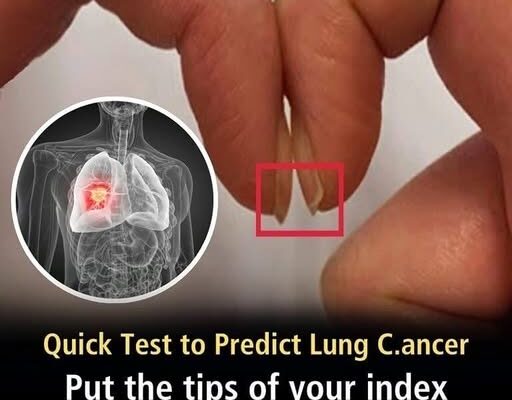In recent years, health professionals have placed increasing emphasis on the importance of early detection when it comes to serious illnesses such as lung cancer. One simple but lesser-known method that has been gaining attention is the finger test, a self-check technique that can reveal signs of potential underlying disease. A woman in the United Kingdom, with support from oncology nurse advisor Emma Norton, has been raising awareness about this unusual yet effective approach. The test focuses on identifying a condition called finger clubbing, which, although not exclusive to lung cancer, can act as an important warning sign.
The test itself is known as the Schamroth window test. Performing it requires no special equipment, just your own hands. To carry it out, you simply place the fingernails of your two index fingers against each other, nail to nail. In healthy individuals, this creates a tiny diamond-shaped gap—commonly called the “Schamroth window”—between the bases of the nails. If this window is missing, and the nails seem to press flush against one another without leaving a gap, it may suggest finger clubbing. Though the test is simple, its implications can be significant.
Finger clubbing occurs when the tips of the fingers enlarge and the nails curve more noticeably around them. This physical change develops gradually and is often linked to conditions that reduce oxygen levels in the blood. The body responds to chronic low oxygen by increasing blood flow to the fingertips, which, over time, alters their shape. Clubbing has been associated with a number of underlying medical conditions, the most serious of which include lung cancer, chronic lung diseases, and certain heart problems. While not every person with clubbed fingers has cancer, the symptom is a red flag that warrants medical evaluation.
One of the challenges with finger clubbing is that it can go unnoticed. Because the changes happen slowly, many individuals are unaware that their fingers have altered shape. This is why awareness campaigns play such an important role: they encourage people to look more closely at their own bodies and to perform quick, non-invasive checks like the Schamroth test. As Emma Norton points out, many people do not know what finger clubbing looks like, nor do they realize its potential connection to lung cancer. By sharing this knowledge, individuals can be empowered to seek medical help sooner rather than later.
The significance of catching lung cancer early cannot be overstated. Lung cancer often develops silently, with symptoms such as cough, fatigue, or weight loss appearing only in later stages. By the time many patients are diagnosed, the disease is already advanced. This is why early warning signs, even seemingly small ones like changes in the fingernails, can make a profound difference in outcomes. Prompt consultation with a healthcare professional after noticing clubbing or other unusual physical signs allows for earlier testing, earlier diagnosis, and potentially more effective treatment.
It is also important to remember that the Schamroth window test is not a diagnostic tool on its own. The absence of the window does not prove cancer, and the presence of the window does not guarantee health. Rather, it is a screening clue—a signal that further medical evaluation is advisable. Doctors may recommend imaging tests, lung function studies, or blood work to determine the underlying cause. Even if lung cancer is not present, detecting other conditions such as chronic lung disease or congenital heart problems can also lead to timely care.
Raising public awareness about the finger test is a small step that can have a big impact. It offers people a way to check for a possible sign of disease in just a few seconds. If more individuals recognize the absence of the Schamroth window as unusual and seek medical advice, it could lead to earlier diagnoses and better outcomes. For anyone who notices changes in their nails, fingertips, or the loss of the diamond-shaped gap, the message is clear: don’t ignore it. Consult a healthcare professional and take action early.



